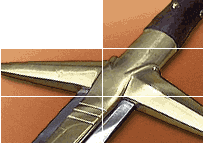
 |
|
|
"Hey Mister... Is that sword real?"
An article by John Clements 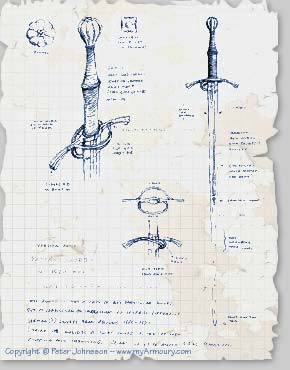 A swordsmith colleague of mine, Dan Maragni, once related an anecdote that he found profound. He was transporting a sword he had made from his home to his car when a child saw him and asked, innocently enough, "Hey mister, is that sword real?" He recalled how the child's question made him stop and consider it at face value for a moment: here was a tool he had constructed by hand in a manner he knew was only a loose approximation of how a historical blade would have been produced, and which he had created based on information he knew was only a rough estimate of the geometry and profile of the original specimen from which it was taken.
A swordsmith colleague of mine, Dan Maragni, once related an anecdote that he found profound. He was transporting a sword he had made from his home to his car when a child saw him and asked, innocently enough, "Hey mister, is that sword real?" He recalled how the child's question made him stop and consider it at face value for a moment: here was a tool he had constructed by hand in a manner he knew was only a loose approximation of how a historical blade would have been produced, and which he had created based on information he knew was only a rough estimate of the geometry and profile of the original specimen from which it was taken.Yet, in essence it was certainly a "sword" by definition. He realized, logically, that you can take most any piece of modern steel, grind it into some sort of blade shape, heat-treat it in some way so it's hard yet flexible, put some sort of handle grip on it, and finally, sharpen it to some degree (or not) and it will certainly be capable of killing. It will be a functional weapon in some regard—but is it a real sword? The question stuck with him and was to influence his research and experiments in reconstructing the art and science of historical sword making. What exactly makes a sword "real"? Is a well-made 19th century era forgery of an authentic 14th century piece still a real sword? What about an expertly and exquisitely crafted yet horribly proportioned and unbalanced modern fantasy sword? What about a piece of spring steel ground to a blunt edge and point with a simple metal cross guard welded to it? For that matter, how about an ancient sword that was poorly constructed and terribly heat-treated but nonetheless produced sincerely by some maker centuries ago? The answer is these are all "swords" to one degree or another. The fact is there is no archetypical "Sword" by which to contrast and evaluate all others. As swordsmith Peter Johnsson rightly observes, in a sense there actually are many different "sword archetypes" but each with different aspects that different people will consider important depending upon their experiences, and certain aspects will often become stressed out of importance to the neglect of others. I found the question that puzzled my friend about what was a "real sword" equally intriguing and more than just a philosophical exercise. It goes to the heart of the craft of modern sword production—which for any serious student of historical fencing studies practicing today is an issue of great importance. The more a tool accurately reflects the actual performance characteristics of the originals, the more it will permit understanding of the real techniques and historical methods for using them—techniques and methods devised by and for such real weapons. There is no question that the less your training tool handles like the historical models, the more distortion will creep into your understanding of the historical ways of fighting with it. The quality and accuracy of the replica swords you train with is vital since, without exception, the tools you use will influence the perceptions you have about the proper handling and function of real weapons in real combat. This in turn will reflect on your assumptions about historical fencing, which will then affect your interpretation of the source manuals—what could and could not be done with such a bladed weapon in real combat, and what should and should not be done in practice today. In the end, accurate interpretation and reconstruction of Renaissance fencing skills depends upon using realistic tools in a realistic manner. But for most all practitioners today actually getting such realistic tools is the first part of the problem. 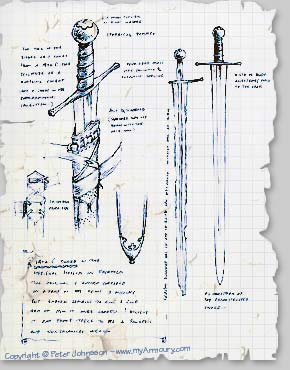 The early 20th century arms collector and fencing historian Sir Frederick Pollock wrote in 1911 on the qualities of ancient as well as (then) modern swords, stating: "A good sword should be elastic, so as to stand bending or a heavy blow without breaking or permanent deformation, and yet stiff enough to deliver a powerful thrust without yielding too readily from the straight. It must also be as light as is possible consistently with strength, and well balanced. All four desiderata are met in the main by the use of suitable steel, properly treated and disposed, but balance is also dependent on the weight and form of the hilt. As regards the effect of disposition, grooving or 'fullering' the flats of the blade reduces weight without impairing strength, and is now very largely adopted."
The early 20th century arms collector and fencing historian Sir Frederick Pollock wrote in 1911 on the qualities of ancient as well as (then) modern swords, stating: "A good sword should be elastic, so as to stand bending or a heavy blow without breaking or permanent deformation, and yet stiff enough to deliver a powerful thrust without yielding too readily from the straight. It must also be as light as is possible consistently with strength, and well balanced. All four desiderata are met in the main by the use of suitable steel, properly treated and disposed, but balance is also dependent on the weight and form of the hilt. As regards the effect of disposition, grooving or 'fullering' the flats of the blade reduces weight without impairing strength, and is now very largely adopted."So what elements can we reason make up a sword such that we can feel the most confidence in calling it "real"? Without question, it is more than a mere matter of material construction along with heat-treating and tempering. Surely the important aspects of a sword, as has been said, are its edge, its cross sectional shape, taper, weight, and its balance. But while all of these are quantifiable to a large degree, their actual parameters are the key and these (whatever the dimensions and geometry of a particular family of blade types) are open to considerable interpretation. That is, unless you start by taking detailed measurements of actual surviving antique swords on which to go. An important element of historical blades (often overlooked in modern reproduction versions of historical swords) is that of the dynamic proportions and variations of the cross-section's shape—or the "cross-sectional differential". That is, the subtle minute changes in the shape, thickness, and taper of the blade along its entire length, from tang to point. As respected European swordsmith Peter Johnsson stresses, this is not a matter of any simple uniform gradation from wider at the hilt to narrower toward the point. The cross-sectional differential of a blade is one of the most crucial aspects of a sword's composition—particularly among cutting swords. Changes in cross-section are a means of mass distribution in order to affect the weapon's weight, balance, and cutting capacity, as well as ensure the blade's sturdiness and reduced vibration upon impact. The overall affect is to produce an agile and effective tool. This is why accurate 3-dimensional measurements of cross-sectional geometry, not merely similar outline and basic dimensions, are so important when making a historical replica that will feel and perform like the original. Doing this today, of course, takes knowledge, artistry, skill, and time on the part of a maker—all of which mean more cost to the consumer. It is an area of importance seldom appreciated or even considered in a great many modern replica swords. Yet, to accurately reproduce a historical piece with the same performance characteristics as the original understanding the cross-sectional differential is an imperative. This is not just a matter of matching the basic shape or even geometry and dimensions of an original blade, but of duplicating the subtle changes in mass distribution that affect the weapon's weight and balance, and thus its handling. To properly reproduce the cross-sectional differential, accurate measurements must be taken of an original blade's thickness at numerous locations along its length from the center of the blade out toward the edges (capturing elements like angle and convexity of the edges, radius and depth of fullers and hollow grinds, and degrees of profile and taper). Attention must also be paid to subtle shaping changes between these measurements and even the width and thickness of any fuller. Also, the geometry and shape of a real sword is not only about the fighting portion of the blade. Even the tang can typically have changing width and taper as well as thickness and if made too narrow or thin at the shoulder, they will break under the stress of swinging. 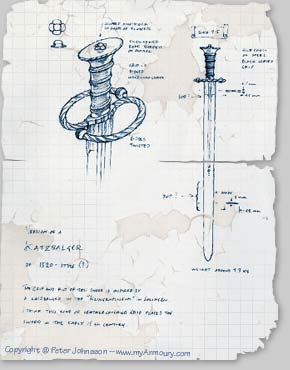 Again, Peter Johnsson emphasizes the degree of difference in shape and thickness of a blade's cross-section is much more than the result of a straight graduated taper from thicker to thinner portions or even the inclusion of a distal taper on the last quarter. The changes in overall shape and thickness are not distributed evenly along a blade's length, but make subtle deviations and so cannot be merely extrapolated from a couple of measurements. Cross-sectional variations are also not uniform like a wedge, but rather alter at key locations along the blade. These changes are in most cases imperceptible to the naked eye (the longer the blade, the more measurements on an original specimen are necessary to record these changes to gain insight into blade design).
Again, Peter Johnsson emphasizes the degree of difference in shape and thickness of a blade's cross-section is much more than the result of a straight graduated taper from thicker to thinner portions or even the inclusion of a distal taper on the last quarter. The changes in overall shape and thickness are not distributed evenly along a blade's length, but make subtle deviations and so cannot be merely extrapolated from a couple of measurements. Cross-sectional variations are also not uniform like a wedge, but rather alter at key locations along the blade. These changes are in most cases imperceptible to the naked eye (the longer the blade, the more measurements on an original specimen are necessary to record these changes to gain insight into blade design).As distinguished swordsmith Paul Champagne describes, knowing how best to impart these attributes to a blade in order to improve its performance was a major component of the historical swordsmith's art. Samples of changes in cross-section taken from original swords of the 15th and 16th centuries reveal there are consistencies among various families of blade types, such as wider and more flexible cutting ones and narrower but stiffer thrusting ones, according to swordsmith Peter Johnsson. Peter adds, "Variations of dimensions within specific functional types generally follow certain parameters of "harmonic" proportions. In the ancient designs we can see examples on how the important functional sections at the shoulder, mid points, and center-of-percussion, are given special consideration"—areas we note correspond to the three divisions of a blade associated with the key functions of guarding, engaging, and striking. Because of this, a sword cannot be examined solely from a silhouette or face-on view. It must be examined based upon its whole blade profile—i.e., its complete volume or shape, length, width, center of balance, pivot point, and differences in thickness and changing taper along its cross-section. As Peter Johnsson notes: "An effective distribution of mass, a graceful distal taper and a proper placing of the nodes of non-vibration are important prerequisites for a responsive and effective cutting weapon. If the blade of a sword has good proportions and is of correct heft, it is possible to give it a balance that induces a soft pull forwards without making it awkward or cumbersome. This will help direct the blade as it is wielded. To make this possible it is necessary to concentrate the mass of a sword to its point of gravity... a well proportioned [cutting] sword will feel solid and deliver blows with authority... To achieve this, utmost care must be given to the shaping of the tang and the adjusting of the blade." Again, this is best achieved by working the metal by closely following measurements of an original. Paul Champagne points out that producing a replica blade with the proper geometry will by default place the necessary elements exactly were they need to be without extra effort—in this way they occur naturally on their own. The result is a weapon that works in battle and this can be determined by cutting with the edge against targets, not swinging it in empty air or slapping the side of a blade to see it wobble. One frequently misunderstood characteristic of a sword is its necessary flexibility. A fighting sword as a lethal tool had to not just deliver strong cuts or solid thrusts but also withstand the rigors of combat, deflecting blows and clashing against armor and other weapons. All this is reflective of the quality of its steel and tempering. Heat-treating is in itself an art that has to be just right to produce a resilient blade, and is one of the distinguishing marks of a talented bladesmith. But a modern myth is that in order to show "good tempering" in a sword, it must be capable of bending considerably and returning true. Real historical weapons are in fact typically quite stiff, in particular foyning blades such as rapiers, small-swords, and duelling epée's. There are even variations in the stiffness of different blades designed for cutting at different materials, those for cutting and thrusting use, and those designed for thrusting only. Most importantly, each time you bend a sword to "test its flex" or "show its quality", you cause micro-fractures in its molecular structure. It's one thing to give a sword an initial flex to see whether it is too rigid or too soft—but remember this is an initial test to determine its quality for resisting blows without snapping too easily or staying bent afterward. Repeating the process over and over only weakens the blade. In actual use, a sword, whether designed for dedicated cutting or determined trusting, did not need to be flexed over and over. Only in the 18th century did they begin to utilize especially flexible practice blades and, thanks to Hollywood, this mindset of needing swords to be able to safely go "boing" over and over against an opponent in the classroom has seeped into the public's conception of what makes a good sword blade. 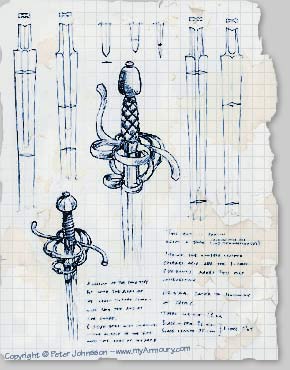 Another element of a real Medieval or Renaissance sword is its edge, or rather, the bevel from its center out toward the intersecting point of the planes of the two sides. The edge then is not just the sharp part but also the entire surface angle. Commonly however, we refer to the edge of a sword as being its degree of sharpness, and here there is considerable misunderstanding and debate as there are different degrees of sharpness and ways of polishing edges. Even then, there are differences between edges for soft versus hard targets. The variety of possible edge types for impacting different targets is considerable. Most cutting swords do not have a knife-like wedge-shaped edge (which can fold upon impact) but more of a rolled teardrop cantle shape that is stronger. As well, edges for slicing soft yielding materials are not the same as those for shearing harder resistant materials. Expert swordsmith Dan Maragni explains the importance of the edge on cutting swords by noting: "The edge is in many ways the most important part of the sword. This is the interface between the blade and the target and must be properly shaped and presented to maximize the effects of the cut. If the edge is shaped incorrectly for the target, too thick or thin depending on hard or soft targets, it will either not bite' or it will fail by either chipping or collapsing on contact." Paul Champaign also suggests, "Think of a sword edge as a shape moving through water, the least resistance will win. This has nothing to do with ease of sharpening, chip resistance, blade handling, or manufacture, etc. As the target gets harder you have to adjust the 'meat' of the rolled edge or the angle of the cantle, etc. You could also leave the edge the same and soften the edge so it won't chip. There are multiple solutions to the problem...it's all in the execution. The best solution is the one that holds up the best to the various things you have to cut." He adds, "Different periods and sword types will use different bevel and edge geometries according to what they are intended to do, just as the blade shape changes between a cutting blade and a thrusting one."
Another element of a real Medieval or Renaissance sword is its edge, or rather, the bevel from its center out toward the intersecting point of the planes of the two sides. The edge then is not just the sharp part but also the entire surface angle. Commonly however, we refer to the edge of a sword as being its degree of sharpness, and here there is considerable misunderstanding and debate as there are different degrees of sharpness and ways of polishing edges. Even then, there are differences between edges for soft versus hard targets. The variety of possible edge types for impacting different targets is considerable. Most cutting swords do not have a knife-like wedge-shaped edge (which can fold upon impact) but more of a rolled teardrop cantle shape that is stronger. As well, edges for slicing soft yielding materials are not the same as those for shearing harder resistant materials. Expert swordsmith Dan Maragni explains the importance of the edge on cutting swords by noting: "The edge is in many ways the most important part of the sword. This is the interface between the blade and the target and must be properly shaped and presented to maximize the effects of the cut. If the edge is shaped incorrectly for the target, too thick or thin depending on hard or soft targets, it will either not bite' or it will fail by either chipping or collapsing on contact." Paul Champaign also suggests, "Think of a sword edge as a shape moving through water, the least resistance will win. This has nothing to do with ease of sharpening, chip resistance, blade handling, or manufacture, etc. As the target gets harder you have to adjust the 'meat' of the rolled edge or the angle of the cantle, etc. You could also leave the edge the same and soften the edge so it won't chip. There are multiple solutions to the problem...it's all in the execution. The best solution is the one that holds up the best to the various things you have to cut." He adds, "Different periods and sword types will use different bevel and edge geometries according to what they are intended to do, just as the blade shape changes between a cutting blade and a thrusting one."As to the much misunderstood value of "layering" in a blade, again Paul Champaign explains the simplicity of why there are layers in ancient swords: "It was an integral part of the steel/iron making process. Today we think of steel in nice bars of various sizes that we can go buy with the particular chemistry we desire. When you make steel in the old way it's not quite that simple. The iron and steel would be in small pieces as a result of the smelting process. These small pieces would all vary in their properties (trace mineral inclusions, chemistry, carbon content)." Modern stock steels thus do not require they be "folded." Paul further explains how the swordmaking process itself produces layering by default: "Any large pieces would have to be broken up into smaller pieces because they might contain impurities such as slag, unburned charcoal, pebbles, etc., etc. These small pieces would have to be combined to make the larger pieces one needs to for a block of metal large enough to form a weapon or tool. The more metal needed the more pieces stacked together. Think of it as taking small pieces of clay and sticking them all together to create a larger stack of clay. That being said, the presence of layers does not mean the weapon is good or bad. The skill of the swordsmith determines that—skill in choosing the proportion of different carbon contents, his skill in forge welding (sticking the pieces together without air bubbles and gaps) is the first step where things can go right or terribly wrong. Once there are a bunch of these pieces stuck together this lump would be forged into a longer bar then folded upon itself over and over again to blend the various pieces together for a more homogeneous piece of metal." He adds finally, "Different cultures and eras within cultures combined them in different ways, one way not necessarily better than another. For example there were many strong and sharp Katanas out there in the 1500s and a whole lot of inferior ones too. Same occurred earlier among Viking blades." The facts are that each time the stack of metal is folded the layers are doubled, but eventually too many foldings, perhaps more than a dozen or so, can actually weaken the structure. 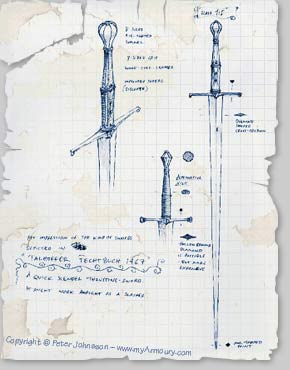 Finally, weight and balance are important characteristics of real swords. It is at last becoming better known that real swords are not heavy. They are not the ponderous unwieldy things of notorious stage and screen fight scenes. They were agile, quick, and robust tools. But still, some of the public do not feel a sword is good unless it feels "heavy". To be honest, sometimes this weightiness is due to a much too thick blade (and equally large hilt or pommel added to counteract it), while at other times the problem of weightiness is due to a user's lack of conditioning and experience. Yet, at the opposite extreme some replica swords are made too thin and lack sufficient mass and heft to seriously guard against strikes, let alone make effective shearing blows on substantial target materials. Reducing the weight is not about just grinding away at the thickness of a blade, nor is adjusting the balance about adding a heavier pommel or guard to an already heavy blade. A blade with appropriate mass-distribution created through proportionate cross-sectional differences, and matched to a suitable hilt will not feel heavy or unbalanced (This is the very reason so many historical blades are reported to "feel" so incredible).
Finally, weight and balance are important characteristics of real swords. It is at last becoming better known that real swords are not heavy. They are not the ponderous unwieldy things of notorious stage and screen fight scenes. They were agile, quick, and robust tools. But still, some of the public do not feel a sword is good unless it feels "heavy". To be honest, sometimes this weightiness is due to a much too thick blade (and equally large hilt or pommel added to counteract it), while at other times the problem of weightiness is due to a user's lack of conditioning and experience. Yet, at the opposite extreme some replica swords are made too thin and lack sufficient mass and heft to seriously guard against strikes, let alone make effective shearing blows on substantial target materials. Reducing the weight is not about just grinding away at the thickness of a blade, nor is adjusting the balance about adding a heavier pommel or guard to an already heavy blade. A blade with appropriate mass-distribution created through proportionate cross-sectional differences, and matched to a suitable hilt will not feel heavy or unbalanced (This is the very reason so many historical blades are reported to "feel" so incredible).The issue of a sword's balance itself is often asserted as being a measurable quality, and while this is true from an engineering perspective, in terms of fencing balance is much more subjective. A sword that feels well balanced to one fighter may not seem so to another. The feel of a good sword is a factor of its handling capacity, and this is a matter of its mass as well as the distribution of that mass along its entire length for the form of sword in question (i.e., straight or curved, long or short, wide or narrow). This is the difference then between what has been called static balance, or its heft, and dynamic balance, or its play in handling (that is, "how it acts when in motion", as bladesmith Dan Maragni explains it). The most important question to ask about a sword is what is it being made for? This concern alone will determine to what degree you can consider a sword "real". A sword made only for hanging on the wall, using as a theatrical prop, or wearing on your side with a costume hardly has to match the requirements of a martial art training weapon to be used in training at full speed and force. A reenactment or stage-combat blade employed in controlled play and endless banging edge on edge also does not need the suppleness or resilience of a sharp reproduction to be used in serious test cutting. So the issue of what your intended purpose is for a sword is vital to what elements of real fighting weapons you will necessarily want to incorporate into a piece. Yet, any or all of the above kinds can certainly be made with concern for the attributes found in historical swords. Historically though, swords for self-defense and war were not identical to those for practice or play. For instance, we know that blunt weapons were used in knightly tournaments, and that by the late 15th century in Western Europe special narrow and thick practice blades were being produced (they had the same mass and balance as real combat blades but their different shapes made them safe for practice). By the early 16th century blunt-tipped thrusting swords were used as well and this continued into later centuries where extra-flexible thrusting swords as well as especially narrow cut and thrust blades were developed specifically for dueling practice and sporting contests. Lastly, an important part of a real sword is its hilt. It has been written before how a sword is only as good as its hilt. If it has a poor handle and grip that flies apart upon swinging or striking, or the tang has a design flaw that causes it to snap when the weapon is torqued around, then the whole value of the sword as a weapon (for either real use or practice) is defeated. The engineering of how the pommel and guard and handle are fitted together is also very important, as there are several ways of getting it wrong. 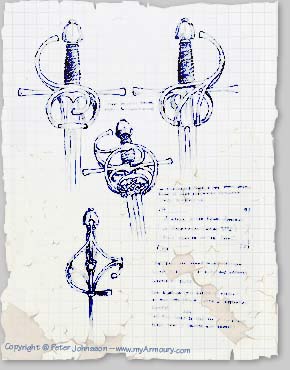 Given the above information, I offer this caution: I am firmly convinced that some of what you have read above, a large majority of the sword industry and custom manufacturers presently do not know. (While other portions of the above I am strongly starting to suspect they simply do not want you to know, or at the least, don't want you to believe). This is why for serious historical fencing enthusiasts many of their wares still leave much to be desired when contrasted with historical specimens—and it certainly doesn't win me friends among some of them to bring this to the public's attention.
Given the above information, I offer this caution: I am firmly convinced that some of what you have read above, a large majority of the sword industry and custom manufacturers presently do not know. (While other portions of the above I am strongly starting to suspect they simply do not want you to know, or at the least, don't want you to believe). This is why for serious historical fencing enthusiasts many of their wares still leave much to be desired when contrasted with historical specimens—and it certainly doesn't win me friends among some of them to bring this to the public's attention.In order to manufacture a replica sword that would perform correctly you have to know something about how it was actually used as a tool. When designing or producing one you also really have to follow from close examination of an original. If a maker is guessing at its measurements and extrapolating its other attributes, the final result is going to be off from the original—and this is indeed the current situation with many modern swords. To use an analogy, it is like trying to reconstruct an antique automobile by following only from photos of one. You could get the look and the color right, but unless you were able to get under the hood of the real thing and examine its parts, you could only guess at its engine performance when building your own version. If instead, you start from scratch with a new design of your own, that's fine. However, we should not pretend such a model reflects the equivalent working knowledge of generations upon generations of skilled craftsman who produced fighting blades for genuine swordsman to use when defending their lives. It is here that the modern "interpretive" or fantasy pieces, devised perhaps with aspects of a historical piece as inspiration but diverging through the creative artistry of the maker, come into the question. The variety and ingenuity of ethnographic edged weapons is enormous. One can only marvel at the diversity of designs of actual historical sword types developed to answer the ancient question of how to successfully defend oneself and engage opponents. So, given the enormous number of existing swords types in museums and collections around the world each with unique and distinct blade shapes and hilt forms (of which many are little known and have yet to be replicated), it is in one sense something of a shame that so many swordmakers today feel the need to express their art with their own creations before ever attempting to really understand the original objects as functional tools. In one sense it is an easy way out. It's easier to create your own ideal and interpretation than to "copy" some long ago version. Regardless, it is certainly the responsibility of the sword maker to provide evidence that a design is martially sound or could have been historically viable. We cannot simply go with the view that we have no way of knowing whether or not in the past they might have made swords of an imagined style or not. And this is precisely where the importance of relying on the accurate dimensions and proper geometry (particularly cross-sectional differential) of real historical swords is so vital to re-producing good swords today. It is fundamental for modern swordsmen able to have access to quality swords, and this will only happen as the sword maker's art is reconstructed from the best historical sources—that is, the old weapons themselves. Logically, if all the dimensions and geometry of an original blade and hilt are reconstructed, the result will reproduce the balance and handling characteristics of the original. Otherwise, a replica sword that does not do this, even if it matches the dimensions, shape, and even weight of an original, will just not have the same blade play to it and will simply not handle in the same manner. What is produced is a noticeably faulty imitation. This is the very problem with a great number of replicas today. Yet, without the understanding that comes from close examination and handling of authentic Medieval and Renaissance sword specimens, something of which too few individuals have experience, there is really no way to address this problem except as attempted here. Historical swords developed over past ages as weapon designs which had been perfected by long trial and error, and which had proven themselves in earnest use. Their makers were masters at the intricacies and subtleties of the heat and handiwork involved in producing fine blades. For today's sword enthusiast however, it does not matter as much whether a blade was produced from a piece of stock steel or hand-forged ore—in terms of the quality of the metal that is. For modern steel is of a reliable and scientifically controlled consistency. So, for the overall form of the blade the stock removal process (grinding into shape by hand or computer guided machine) is essentially as good as hand-smithing (hammering into shape from a block of soft metal while red hot). But, note carefully, this applies only to the overall form of the blade. To ensure the subtleties of the cross-sectional shape and taper profile (elements which as explained are crucial) these can only be properly controlled by the expertise of handcrafting by a skilled artist relying on expert data. 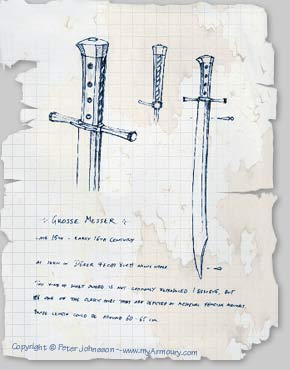 As sword expert Ewart Oakeshott once pointed out, "The blade of a [cutting] sword has to fulfill three requirements: it must have reasonable weight at the centre of percussion, or optimal striking point; at the same place it must have reasonable breadth; and its section must be flat. You cannot shear through flesh and bone with a thick blade with an edge at an obtuse angle. You need a blade of flat section, with a fine edge coming off at an extremely acute angle." (Oakeshott, European Weapons and Armour, p.137). Noted swordsmith Paul Champaign eloquently explains the facts of just how it is that a real sword works as an effective cutting tool: "It has mass, you swing it, it impacts with a target and the force is concentrated and transmitted at the 'edge' into the target. Different edge geometries work better on certain materials than others to do this. To get more than one hit out of a sword it can't be too brittle (or it snaps) or too soft (or it takes a set bend). The faster you strike and the heavier the sword is the harder you'll hit. However, the heavier it is the harder it is to make dramatic changes in direction once the sword is in motion. The lighter the sword is the less strength is required to move it quickly—but the less force it will have upon impact at a given speed. More weight will concentrat on the point of impact to cause a more forceful hit, but will also produce an un-wieldy blade due to a balance point that is very close to the tip (e.g., an axe). Flaws in the metal will cause an increased chance of sword breakage. Even without flaws, constant hitting against armor and other hard things will cause an increased chance of breakage. Poor heat-treatment or poor overall design will also trigger increased chances of sword breakage."
As sword expert Ewart Oakeshott once pointed out, "The blade of a [cutting] sword has to fulfill three requirements: it must have reasonable weight at the centre of percussion, or optimal striking point; at the same place it must have reasonable breadth; and its section must be flat. You cannot shear through flesh and bone with a thick blade with an edge at an obtuse angle. You need a blade of flat section, with a fine edge coming off at an extremely acute angle." (Oakeshott, European Weapons and Armour, p.137). Noted swordsmith Paul Champaign eloquently explains the facts of just how it is that a real sword works as an effective cutting tool: "It has mass, you swing it, it impacts with a target and the force is concentrated and transmitted at the 'edge' into the target. Different edge geometries work better on certain materials than others to do this. To get more than one hit out of a sword it can't be too brittle (or it snaps) or too soft (or it takes a set bend). The faster you strike and the heavier the sword is the harder you'll hit. However, the heavier it is the harder it is to make dramatic changes in direction once the sword is in motion. The lighter the sword is the less strength is required to move it quickly—but the less force it will have upon impact at a given speed. More weight will concentrat on the point of impact to cause a more forceful hit, but will also produce an un-wieldy blade due to a balance point that is very close to the tip (e.g., an axe). Flaws in the metal will cause an increased chance of sword breakage. Even without flaws, constant hitting against armor and other hard things will cause an increased chance of breakage. Poor heat-treatment or poor overall design will also trigger increased chances of sword breakage."This explanation then, covers a wide range of elements making up an effective weapon and yet includes the understanding that even "real" swords can be made with flaws that affect their performance and utility. How do we call a replica an "authentic" reconstruction then? Even though the blade may be made in a modern forge from modern steel, the matter is about whether it is based not merely on general measurements of an original piece but the precise style and dimensions of one (minus any obvious flaws). This is where the talent and experience of the craftsman comes into play. I really love swords and in the past few years I have had the rare pleasure of closely examining well over 200 antique European specimens from the 14th to 17th centuries—more different originals now than I've handled replicas. The more I know of the real ones the more "magical" they seem when I reflect upon all that went into making one, and unfortunately, the more disheartened I feel about most replicas. But I am increasingly hopeful as information becomes available like with this article. The bottom line for historical fencing students is that swords are tools and should be viewed as such. People today it seems are much too emotional about their swords—an unwarranted attitude given the widespread ignorance about actual historical pieces and the fact that we no longer rely on them for saving our lives. There is still much for sword makers and sword users to consider in this subject. There is still much for sword enthusiasts to be educated upon. The key spathological question then, as the child asked, "Is that sword real?" is one to continually ponder. About the Author John Clements is one of America's leading instructors and foremost practitioner-researchers of Renaissance fencing. He has practiced the subject since 1980, researched and taught on the subject in six countries, and is director of ARMA, the Association for Renaissance Martial Arts. He is the author of Renaissance Swordsmanship and Medieval Swordsmanship, both from Paladin Press. He writes and teaches on the craft full-time. Author's Thanks Appreciations to Dan Maragni, Peter Johnsson, Paul Champaign, and George Turner. Acknowledgements Images are created from original illustrations by Peter Johnsson |
|